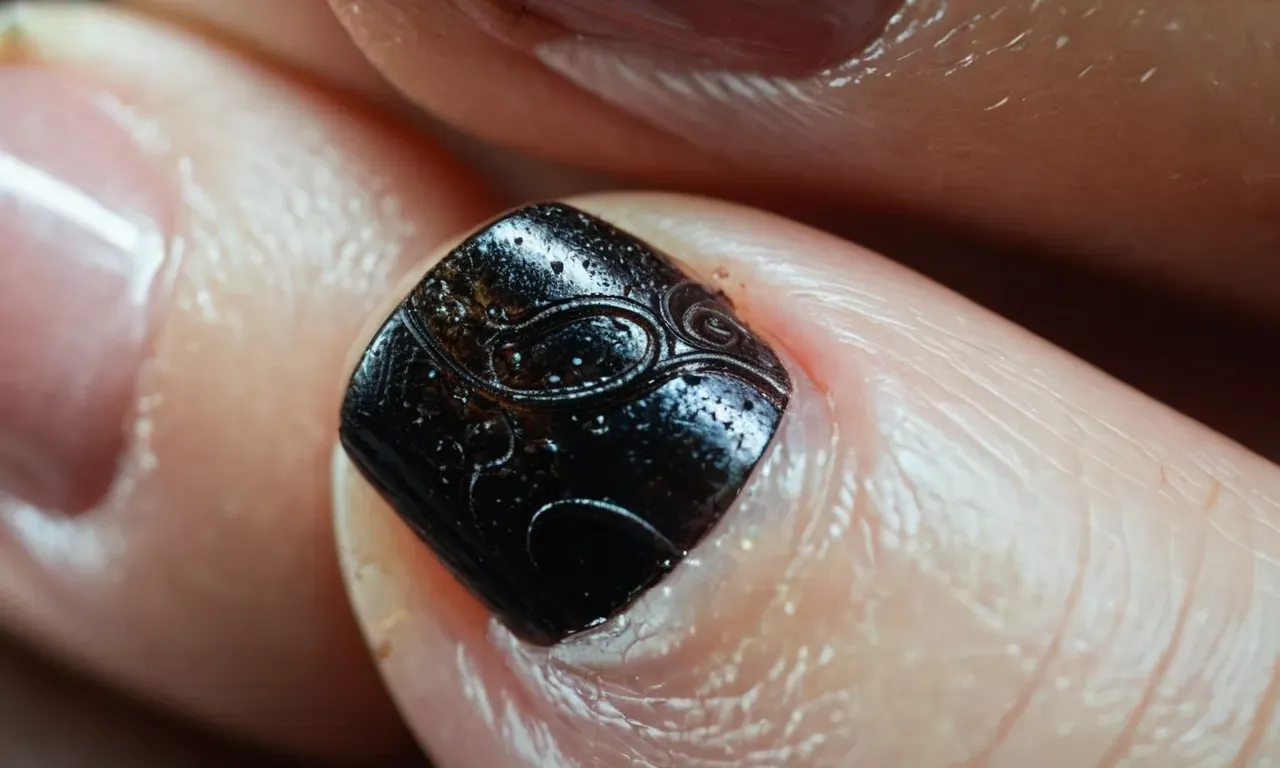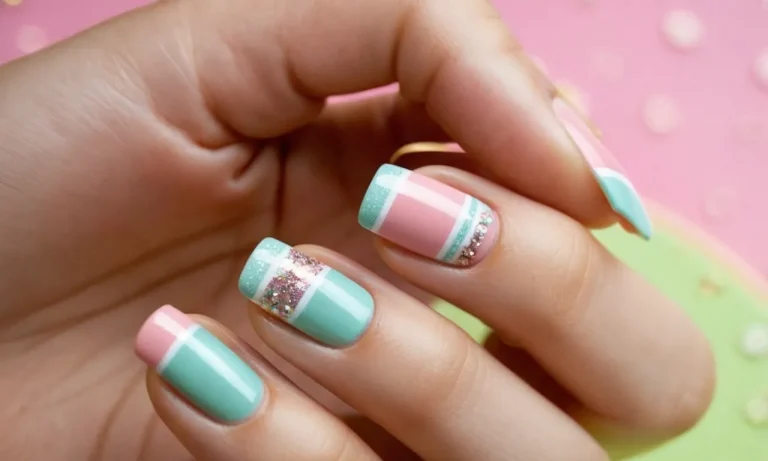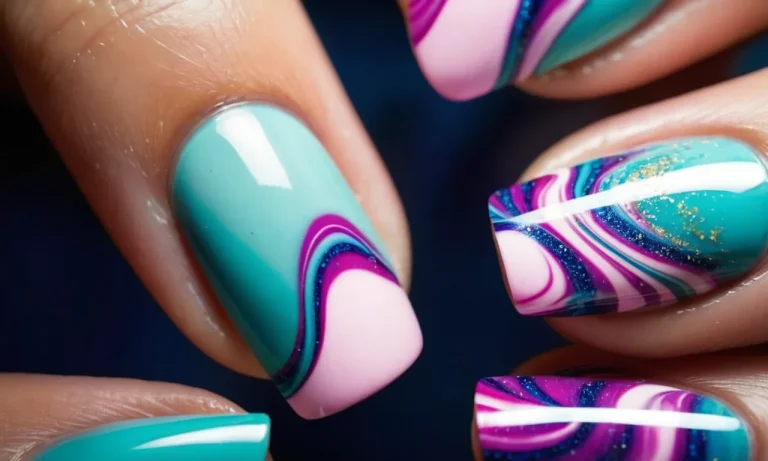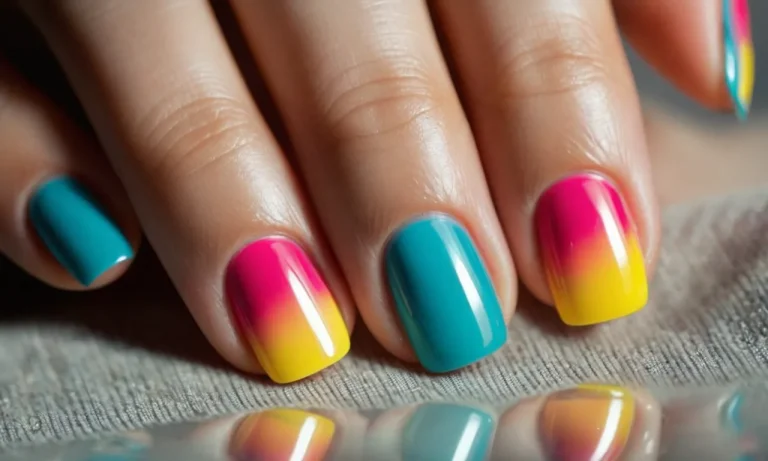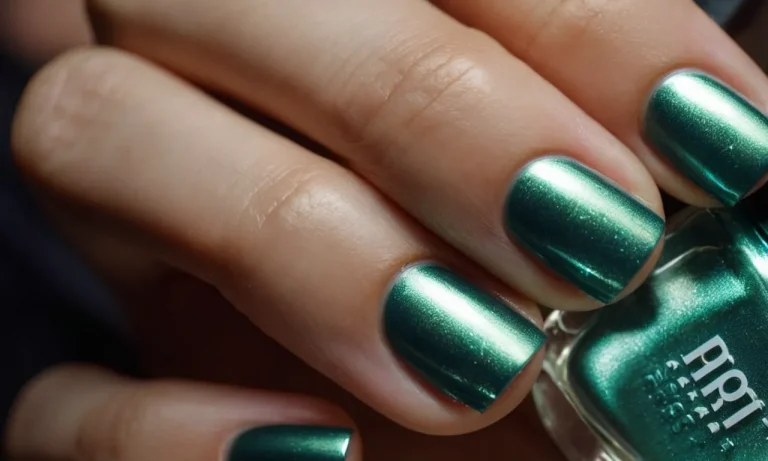Why Are My Toenails Turning Black? An In-Depth Explanation
Have you noticed that one or more of your toenails have started to turn black? A black toenail can be alarming, but in most cases it’s harmless. In this comprehensive article, we’ll walk through all the potential causes so you can get to the root of the issue.
If you’re short on time, here’s the quick answer: Black toenails are often caused by injury, fungal infections, or medical conditions. The most common causes are trauma from tight shoes, dropping something on your toe, and toenail fungus.
What Causes Black Toenails?
Black toenails, known medically as subungual hematomas, can occur for various reasons. Understanding the potential causes can help determine appropriate treatment and prevent future occurrences.
Trauma and Injury
Physical trauma is the most common culprit behind black toenails. Activities like running, hiking, or playing sports can cause the toenail to jam into the toe bed, rupturing capillaries and vessels. Blood pools underneath the nail, staining it black or purple as it oxidizes.
Ill-fitting shoes are a prime offender. Pressure from tight shoes causes repetitive injury over time. One study found nearly 50% of runners develop black toenails from poorly sized running shoes.[1] Wider toe boxes reduce friction to prevent this.
Fungal Infection
A fungal infection (onychomycosis) can also blacken toenails. Fungi invade the nail bed and cuticle, causing thickening, distortion, debris build-up, and dark pigmentation.
Those with nail fungus may notice odor or a foul smell, nail detachment, or white spots on surrounding skin. Once established, toenail fungus is stubborn to treat. But oral and topical antifungal medications can help clear infection and restore normal nail color.
Medical Conditions
Certain underlying medical conditions are linked with black toenail discoloration:
- Diabetes can impair circulation and healing, increasing susceptibility to bruising and fungal infection.
- Kidney failure enables waste buildup in the blood, creating skin and nail discoloration.
- Skin cancer (melanoma) may initially resemble a black streak under the nail.
Therefore, it’s wise to see a podiatrist or doctor if the cause of black toenails is uncertain. They can assess for related medical issues and provide proper treatment.
Trauma and Injury
Tight Shoes
Wearing shoes that are too tight can cause repeated trauma to the toes over time. This constant squeezing and friction can damage the toenails and cut off circulation, leading them to turn black. Some studies have found up to 60% of runners experience black toenails due to tight shoes.
The medical term for this is “subungual hematoma,” which refers to bleeding underneath the nail. Relieving the pressure by wearing properly fitted shoes allows fresh blood to circulate and the nail to heal.
Dropping Something on Your Toe
Dropping a heavy object like a weight or piece of furniture directly on your toenail can instantly cause bleeding and bruising. The impacted toe might throb with pain and the nail can turn fully or partially black within a day or two.
If it’s just bruised and intact, the discoloration grows out with the nail over several months. But if the crush injures the nail bed or causes the nail to partly or fully come off, it will need to regrow the damaged part.
Hitting Your Toe
Stubbing your toes happens to everyone at some point! You might bang your toe into furniture, the stairs, a doorway, or someone’s foot during sports. While painful, most of these impacts only cause temporary bruising and some tenderness.
But a harder trauma that fractures the toe or severely damages the nail can lead to blackening under or over the entire nail. See a doctor if part of the nail is lifted, the toe won’t stop throbbing, or you can’t put weight on it.
Long Distance Running
Logging high weekly mileage training for marathons or ultramarathons increases the chances of developing black toenails. The constant pounding sensation absorbs impact to the feet with each step. Over time, this can cause blood vessels under the nails to rupture.
A 1982 study showed 79% of marathon participants had subungual hematomas afterwards. Wider toe box shoes, properly trimming nails, and wearing thin moisture-wicking socks can alleviate some pressure.
Fungal Infection
Risk Factors
Certain groups have an elevated risk of developing fungal toenail infections. Older adults are more likely to get fungal nails since immunity weakens with age. According to the CDC, adults aged 65 years or older made up over 50% of fungal nail infections.
Having diabetes is another major risk factor – about 36% of people with diabetes develop onychomycosis. The high blood sugar levels make it harder to fight infections. Other medical conditions like psoriasis or athlete’s foot also raise the risk.
Lifestyle factors like swimming frequently, wearing tight shoes, walking barefoot in damp places, or injuring the toenail make fungal overgrowth more likely. Genetics and family history play a role too.
Symptoms
The most common early signs are a white or yellow spot under the tip of the toenail. As the infection progresses, the nail thickens and discolors, turning white, black, brown, or green with debris buildup. The nail may become brittle and crumbly.
In severe cases, the nail separates from the bed and falls off. There can be an unpleasant odor too. Mild infections may not cause pain, but the nail area can become red, swollen and painful if left untreated. See a podiatrist promptly if any symptoms occur to prevent worsening.
Diagnosis
Doctors often diagnose fungal nail infections through visual exam of the toenails. They may also take a nail clipping or debris sample for lab tests to identify the exact fungus. According to the American Academy of Dermatology, microscopic exam and fungal culture of nail specimens can determine the causative fungus in over 90% of onychomycosis cases.
PCR (polymerase chain reaction) tests offer quick and accurate diagnosis. Imaging like X-rays helps gauge infection depth in the nail bed. Proper diagnosis is key before starting treatment.
Treatment
| Treatment Type | Details |
| Medications | Oral antifungals or topical solutions. Takes 6-12 weeks, 70% success rate. |
| Laser therapy | Uses focused light beams to kill fungus. Localized with minimal side effects. |
| Nail removal | Surgical removal for severe cases. Combines medication for best outcome. |
The treatment plan depends on infection severity and health status. Mild cases can clear with over-the-counter topicals, while systemic antifungals are needed for moderate to severe fungus. Per the American College of Foot and Ankle Surgeons, complete mycological cure and healthy nail regrowth takes 9-12 months on average.
Proper nail care and hygiene prevents recurrence. Diabetics need blood sugar monitoring during systemic treatment.
Medical Conditions
Melanoma
Melanoma is a serious form of skin cancer that develops from uncontrolled growth of pigment cells called melanocytes. When melanoma develops under a toenail, it can cause the nail to darken, turn black, or appear brown-black.
As the cancerous cells multiply under and around the nail, it lifts the nail up and causes darkening and discoloration (1). According to research, subungual (under the nail) melanoma accounts for 0.7-3.5% of all cases of melanoma (2). If not treated promptly, it can be fatal.
So seeing any unusual toenail changes like darkening, make sure to get it checked by a dermatologist.
Diabetes
Toenail fungus and ingrown nails are common toenail problems seen in people with diabetes. This increases susceptibility to infections. When blood sugar levels are too high for too long, it can damage the nerves in your toes and lead to poor circulation (3).
This makes it harder for wounds and infections to heal. Untreated infections can spread under the toenail, causing it to appear black. Sometimes gangrene can also set in. So diabetics need to take extra care of their feet and toes and avoid toenail injuries.
Getting regular podiatrist checkups can help catch problems early.
Kidney Disease
Damaged kidneys cannot properly filter waste from the blood. Toxins and waste buildup can manifest as dark and discolored nails. Data shows around half of chronic kidney disease patients can develop changes in their fingernails or toenails (4).
Seeing blackish discoloration in toenails should raise alarm bells to get kidney function tested. The good bit is that treating the kidney disease can help resolve these nail issues. Dietary changes, medication, dialysis, or even kidney transplant helps the person regain their health.
Peripheral Artery Disease
This narrowing of blood vessels can reduce blood flow to the legs and feet. It commonly causes painful cramping in calves when walking which subsides with rest (5). But lack of blood circulation can also damage toenails. They may initially turn spotted, streaked, whitish or blackened (6).
This is because nutrients are unable to reach the nails. If the circulation issues persist, it can increase risk of infection and gangrene. Getting an ABI (ankle-brachial index) test done can help in early diagnosis.
Quitting smoking, medications, angioplasty or bypass surgery are some treatment options.
When to See a Doctor
If your toenails are turning black, it’s important to see a doctor to determine the underlying cause. Here are some general guidelines on when you should make an appointment:
- Sudden change in toenail color – If your toenails suddenly turn black rather than a gradual change over time, it warrants an evaluation by a doctor.
- Pain or discomfort – If the black discoloration is accompanied by pain, swelling, throbbing, or discomfort in the toe or nail, you should be evaluated.
- Injured toenail – If trauma or injury preceded the blackening of the nail, it’s a good idea to have it looked at to rule out infection.
- Diabetes – Blackening nails could signal peripheral vascular disease or neuropathy in people with diabetes. See your doctor to prevent potential complications.
- Numbness or tingling – These symptoms with blackened nails could indicate an underlying systemic condition requiring medical care.
- Immune disorders – Diseases like melanoma or systemic lupus can manifest with blackened nails. Diagnosis is important for proper treatment.
- Fungal infections – If you suspect blackening is due to fungus, anti-fungal creams may help. But see a doctor if it persists despite treatment.
- Routine exams – Bring up the issue at your next physical even if you aren’t having other symptoms. Early diagnosis of many conditions is beneficial.
When blackening nails are due to medication side effects, trauma, or natural aging, a doctor visit may not be urgent. Use your best judgment. Seek care if you have any concerns about your overall health related to the nail changes.
Leaving blackened nails unchecked could allow progression of preventable diseases.
Your doctor can examine your nails and ask about associated symptoms to pinpoint a diagnosis. Fungal cultures, blood work, x-rays, or biopsies of the nail may be done. Based on the cause, your doctor can provide personalized treatment to resolve blackened toenails and advise on proper foot care.
Don’t take chances with your health. Blackened toenails could simply be harmless discoloration. But they might also indicate potentially serious medical conditions like melanoma or diabetes. Schedule an appointment with your doctor when in doubt.
Early intervention can prevent minor issues from becoming major ones. Addressing blackened nails quickly maximizes the chances of restoring your nails and your health.
Treatment Options
Rest and Protection
One of the most important things you can do if you have black toenails is to give your feet plenty of rest and protection. This means wearing comfortable, well-fitting shoes and avoiding high impact activities like running or jumping that can further traumatize the nail bed.
When at home, it’s a good idea to go barefoot as much as possible to give your toenails a break.
You’ll also want to avoid wearing tight shoes or socks that put pressure on the toenails. Give those piggies some breathing room! Trimming your nails straight across can help relieve pressure on the nail bed as well.
Medications
If the underlying cause of your black toenail is a fungal infection, your doctor may prescribe an oral antifungal medication like terbinafine (Lamisil) or itraconazole (Sporanox). For bacterial infections, antibiotics either orally or topically may be used.
These medications work to kill the fungus or bacteria discoloring the nail. It can take several weeks or months for the medications to fully work. Be sure to finish the entire course as prescribed even if the nail looks better.
Surgery
In severe cases where the toenail is damaged beyond repair, partial or complete surgical removal of the nail (nail avulsion) may be done. This is usually an outpatient procedure done under local anesthesia.
After numbing the toe, the surgeon will use an instrument to loosen and lift the nail away from the nail bed. They may also destroy the nail matrix to prevent regrowth. After surgery, the toe is bandaged and you will need to keep it dry and clean while it heals over the next few weeks.
Home Remedies
While medical treatment is best, some simple home remedies may help improve mild cases of black toenails:
- Soaking the feet in warm water with antibacterial soap or Epsom salts can help keep the area clean and draw out infection.
- Applying over-the-counter antifungal creams containing clotrimazole or miconazole directly onto the nail twice a day may help clear up fungal infections.
- Rubbing vitamin E oil onto the nail can promote healing.
- Tea tree oil is a natural antifungal and can be applied to the nail bed.
While home treatments may help, it’s important to see a doctor if the toenail does not improve or continues getting worse. Leaving fungal or bacterial infections untreated can allow them to spread to other nails.
Prevention Tips
Wear Properly Fitting Shoes
One of the most common causes of black toenails is improperly fitted shoes. When your toes bang against the front of shoes repeatedly, it can cause bruising and blood to collect under the nail, turning it black or purple (this is known medically as subungual hematoma).
To help prevent this, make sure to buy shoes that fit well and have adequate toe room. If you have wide or thick toes, opt for shoes made with supple or stretchy materials that can accommodate your feet. Also try loosening shoelaces or straps to reduce pressure on toenails.
Trim Your Toenails
Keeping your toenails trimmed straight across can reduce the risk of ingrown toenails, which can lead to infection and nail discoloration. Use clean nail clippers or scissors meant for thicker toenails, cutting them so they’re even with the tips of your toes.
File down sharp edges gently with an emery board. Try to cut nails after bathing when they’re softer. Those with conditions like diabetes or poor circulation should have a podiatrist trim their nails.
Treat Athlete’s Foot
A fungal foot infection known as athlete’s foot can cause toenails to become brittle, thickened, or darkened. Treating the infection helps prevent permanent toenail changes. Apply over-the-counter antifungal creams containing tolnaftate or clotrimazole as directed.
Keep feet clean and dry, wear moisture-wicking socks, use antifungal foot powder, and avoid going barefoot in public showers or pools. If OTC treatments fail after 3 months, see your doctor about prescription oral antifungals, which may be needed for stubborn infections (up to 12% of North American adults have fungal nail infections).
Inspect Your Feet Regularly
Routinely checking the condition of your feet and toenails helps identify problems early when they’re easiest to treat. Look for any redness, swelling, pain, odor, drainage, thickening, or discoloration, which could indicate emerging issues like infection, trauma, or nail fungal or psoriasis.
Use a magnifying device if needed. Capture photos over time to compare changes. See a podiatrist, dermatologist, or your physician promptly if you notice anything concerning – don’t try to self-diagnose. Quick diagnosis and treatment can help restore toenail health and appearance.
Conclusion
Black toenails are often harmless, but can sometimes indicate an underlying health condition. If home treatment doesn’t resolve the discoloration within a few weeks, make an appointment with your doctor. With proper care, your toenail should grow out and return to its normal color.
We hope this comprehensive guide has helped you understand the various causes of black toenails and given you some ideas for treatment and prevention. Don’t hesitate to seek medical advice if your toenail condition persists or worsens.

